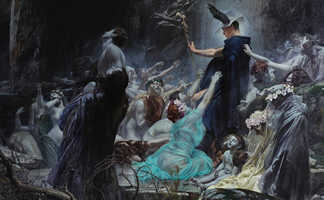The Greek mythological tradition, compared with other mythologies around the globe, is stunning in its complexity and in its inventiveness in explaining natural phenomena. Take the beautiful story of Demeter and Persephone, which explains the changing of the seasons.
The short version of this myth is that Demeter, goddess of agriculture, had a daughter, Persephone, who was kidnapped by a love-smitten Hades, god of the underworld. Demeter rescues Persephone, but not before Persephone ate six pomegranate seeds given her by Hades. Because food consumed in the underworld forever bound that person to that place, the six seeds meant that Persephone would be forced to live six months a year in the underworld, and six months above ground. During Persephone’s absence, the plants of the earth (Demeter’s sphere of authority as a goddess), go into mourning, drop their leaves, and become dormant- winter. However, when Persephone returns to her mother Demeter, the earth breaks forth into fresh, new, green vegetation- summer.
This explanation of the change of the earth’s seasons sufficed until another Greek, the brilliant Oenopides of Chios, calculated, in the 5th century B.C (three centuries later), the 24-degree semi-annual tilt of the earth’s axis which accounts for the annual shift from summer to winter.
How was it that the Greeks myth were so full of color, and colorful characters? The explanation lies in the fundamental shift of focus of the Greek poets who first set down these stories. Greek mythology in its written form begins with Homer, sometime around 1,000 B.C.
This shift in focus involved placing man at the center of the natural world. The Greek gods are beings created in the image of man. Before this, ancient myths were completely disconnected from reality.
Edith Hamilton, the great classicist from the mid-twentieth century, contrasts the human-like Greek deities with the non-human Egyptian and Mesopotamian gods:
“In Egypt, (we have) a towering colossus, immobile, beyond the power of the imagination to endow with movement...or a rigid figure, a woman with a cat's head suggesting inflexible, inhuman cruelty. Or a monstrous mysterious sphinx, aloof from all that lives. In Mesopotamia, there are bas-reliefs of bestial shapes unlike any beast ever known, men with birds' heads and lions with bulls' heads and both with eagles' wings, creations of artists who were intent upon producing something never seen except in their own minds, the very consummation of unreality. One need only place beside them in imagination any Greek statue of a god. so normal and natural with all its beauty, to perceive what a new idea had come into the world. With its coming, the universe became rational.”
Hamilton goes on to say that the Greek poets and artists “realized how splendid a man could be…He was the fulfillment of their search for beauty.”
She then says that this dissipated much of the fear other ancient cultures had towards their deities, which were more like capricious, terror-inducing monsters than gods. Ancient Greeks, having endowed their gods with human attributes, felt much more comfortable with them than the Egyptians or Mesopotamians did with theirs.
Being powerful beings, the Greek gods provoked fear and respect, but on the other hand, they were all too human. Greeks could even laugh at their gods for their familiar human weaknesses. Randy old Zeus, for example, trying to conceal his love affairs from his wife, Hera and often being embarrassed by Hera when she discovers his indiscretions, made them that much more loveable, and archetypes for stock characters one finds in literature and cinema to this day. In fact, much of Greek comedic cinema’s central plots revolve around the exploits of a hapless middle-aged adulterer frantically trying to hide his indiscretions with a younger woman from his suspicious wife.
“That is the miracle of Greek mythology,” Hamilton rhapsodizes. “A humanized world with men freed from the paralyzing fear of…the fearsome spirits with which earth, air, and sea swarmed.” These “fearsome spirits, she goes on to say, were banned from Greece. She makes the further point that the authors of the myths disdained the irrational. Their stories, no matter how absurd, always took place in a world that made perfect sense.
Thus Hercules, who seemed always in combat with “preposterous” monsters, made his home in a specific city, Thebes, while the exact place where Aphrodite arose from the foam of the sea “could be visited by any ancient tourist.” Pegasus, the “winged steed,” spent his nights in a “comfortable stable in Corinth.”
These locales “gave reality to all the mythical beings. If the mixture seems childish, consider how reassuring and how sensible the solid background is as compared with the Genie who comes from nowhere when Aladdin rubs his lamp and, his task accomplished, returns to nowhere.”
Thus irrationality has no foothold in classic Greek mythology. There is no astrology. Stars are mentioned, but it is never implied that they rule our destinies. Likewise, there are no ghosts. Ancient Greeks did not fear the dead- they pitied them.
With very few, relatively unimportant exceptions, the panoply of Greek deities were resplendent in their human beauty. While it is true that at times they could be unpredictable, there is nothing to fear in the beauty of human beings. “The early Greek mythologists,” Hamilton says, “transformed a world full of fear into a world full of beauty.”
Having said this, there are also some negative aspects to Greek mythology. The gods and goddesses often seem to live on a lower moral plane than the nobler human figures. They often do not seem to follow the strict moral code that some famous Greek characters, such as Hector, who fought heroically against the Greeks at Troy, or Penelope, the wife of Odysseus who remained faithful to her husband during his two decade absence from home, exhibited. One sometimes sees unnecessary cruelty or contempt on the part of the Greek gods.
Another negative aspect is the existence of half-human, half animal gods, probably a leftover from a more ancient mythology. You see satyrs- goat-men, and centaurs, horse-men. But these are relatively rare in the Greek canon. There are instances of monsters as well- multi snake-headed Hydra, who would grow two new heads when one had been amputated, terrifying Gorgons, whose look turned one to stone, or the fire breathing lion/goat/snake hybrid known as the Chimera. But these monsters only serve as foils to the exploits of heroes such as Hercules or Theseus.
Greek myths serve a dual purpose: they explain natural phenomena, as cited above with the story of Demeter and Persephone. But they are also entertaining stories of the adventures of the gods and the humans who interact with them, stories that help pass the time around the fire of a long winter evening.
Edith Hamilton defines the myths dealing with the explanation of nature as “early science, the result of men’s first trying to explain what they saw around them.” But there are aspects of early religion in the myths, as well. Zeus, for example, was once a rain god, whose intervention was necessary to preserve life in arid Greece. He eventually evolved, as Dio Chrysostom wrote in the early 2nd century A.D., “Our Zeus, the giver of every good gift, the common father and savior and guardian of mankind.” This version of Zeus looks a lot like the Lord of Hosts of Judaism and Christianity.
The list of writers of the myths is a relatively short one. These are the poet Homer (about 1,000 B.C.), the farmer Hesiod, (around 900-800 B.C.), the writers of the Homeric Hymns (the early 700’s to around 500 B.C.), the poet Pindar and the playwright Aeschylus, (writing in the 400’s B.C.), and the Alexandrian poets (who wrote in Egypt in the 200’s B.C.).
The most important compiler of Greek mythology was the poet Ovid, born in 43 B.C. And then there was Greek geographer Pausanius, in the 2nd century, A.D, the world’s first travel writer, who often wrote of the myths behind the many places in Greece and elsewhere he visited.
In further posts, we’ll be getting into the rich back stories of the twelve gods, and the origin stories of the universe. Greek mythology is fascinating, and always entertaining. These tales have currency even today. Witness the popularity of mythology-based Hollywood and European films during the entire history of cinema, plus more recent examples in popular fiction and TV such as Percy Jackson and the Olympians.





















